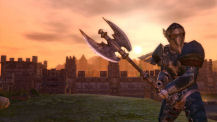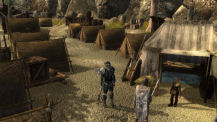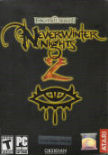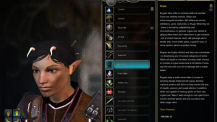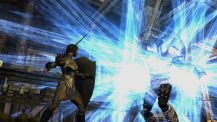Rarely is a game as hyped as when the masters of
RPGs – Bioware - are to release a new title. With Neverwinter Nights
in 2002, Bioware presented the gaming community with the most anticipated
title in the genre since the fabulous Baldur’s Gate II was
released.
Critics were almost drowning each other in a flood
of praise for the game, but the gaming community itself was not impressed.
The game seemed to have it all -- the new integrated Dungeons & Dragons
rules, a fresh new interface, a rich world in 3D to explore and an
unfolding mysterious story. So what went wrong? According to most, the
game lacked a soul. (It is debatable whether a computer game can have a
soul, of course.) Neverwinter Nights was not imbued with the same
magic that made the player want to play Baldur’s Gate over and over
again, to experience the same story until one knew it by the numbers.
Perhaps it was Neverwinter Night’s lack of a real party or its
shallow henchmen. Maybe it was the unremarkable story. No matter the
reason, I personally thought the game was criticized far more than it
deserved. It was not an amazing game, but the immense hype from magazines
and the growing Internet community raised expectations that it could not
meet.
Now, four years, later the sequel has arrived, and
while the hype has not been as thick, the expectations certainly have been
high. This time, with Obsidian Entertainment at the helm, can the game
hold its own against the other games in the genre? Let’s find out.
Neverwinter Nights 2
is, just like its predecessor, played in a real-time 3D world. Most
remarkable is how much easier camera control is, and that the interface
has been slightly improved. Gone are the ugly oversized inventory windows,
replaced by smaller click-and-drag windows. Other than small changes here
and there, it is the same system as before. It may take some time to get
the hang of it, but in a short time one can easily cast spells, use items
and move the characters around without a second thought.
Without spoiling too much of the story itself, the
player assumes the role of a villager, forced from his home by a series of
events that eventually land him (or her) in Neverwinter. The player starts
to uncover a plot with dark and sinister forces behind it (but more of
that later).
Along the way you will – as is the norm – encounter
different characters to help you on your way. Many of these can join your
party, and it is here the greatest improvement from the previous games
(and expansions) lies. While Hordes of the Underdark definitely had
characters deserving of praise, they rarely felt part of the game itself.
In Neverwinter Nights the characters interject, banter with each
other and many have their own quests to be pursued and solved. In a way,
it is a shame that every NPC (non-player character) you meet may end up
following you (or at least hanging out in your current base of
operations). It would have been more interesting to replay the game with
different characters each time.
The most improved aspect of character interaction is
that not all dialogue windows are a simple box in the corner now. For each
“special” NPC you interact with, a special dialogue cut scene opens that
makes it feel a lot more as though you’re actually talking to someone
instead of just choosing between dialogue lines one, two, three and four.
Remember Knights of the Old Republic? The dialogue
system is the same here. Another similarity is the influence system that
seems almost to have been copied straight from KotOR. The way you treat
other people or your companions decides how much they like you, giving you
influence over them. Gaining their trust is never a bad thing, since it
may allow certain paths in the game to be explored. Just keep in mind that
what is acceptable to one companion may be entirely unacceptable to
another. This way, one is almost forced to play a certain type of
character in the game to “experience” what a specific companion might
offer to the story. It is one way to tempt the player to replay the game,
and a good idea.
It would have been more interesting if certain
companions could turn against the player or leave the party. However,
despite how badly you treat them, companions never leave your group. It
seems Obsidian decided to avoid the issue of a mutinous party altogether
and instead focused their energies on making the entire story “as it is
supposed to be played”. Granted, you may only take a few companions with
you each time you venture out of your stronghold, but it still feels
somewhat strange. Sometimes, it is a matter of story consistency, but not
often. Another very annoying aspect of party management is that if one
wishes to change the party composition, the only way to do so is trudge
all the way back to the current stronghold and enter it before once more
exiting and choosing companions from there.
Speaking of the story, this is where the game both
excels and fails at the same time. How can that be? The most disappointing
part of the entire game, unfortunately, is an error that no patch can fix.
This is one of the most linear games that I have ever played. It may offer
slightly more freedom than Dungeon Siege did, but not much. The
entire game consists of the player undertaking quests in a certain area
before solving them, and getting the “reward” of the ability to move on to
the next area.
The few side quests that are available should at
least appeal to the anxious players (like myself, mind you) who fret over
missing something that may lead to acquiring a few extra experience
points. The objectives of these side quests are always located by the path
to the area’s main objective.
As for the story, it is remarkably varying. In some
parts, the story is enough to make you yawn in boredom and write it off as
a cliché, while in others it consists of very interesting ideas and
extremely well written scripts. The companions themselves have an
impressive lot to say, both relevant to the story and otherwise. Some of
it is just entertaining banter and other times consists of different takes
on morality and other similar topics. It is a shame not as much work was
put into the story itself. And did they also have to hire the worst
possible voice actor they could find to speak the epilogue of the game?
The audio in the game is decent overall. Nothing
remarkable, but by no means horrible either. There are the usual battle
cries, weapons clashing and magic spells being cast. No surprises there.
What the developers should be credited with is their excellent choice of
voice actors (excepting the narrator, as mentioned above). All of them are
far above average and really make an effort to step into their respective
roles: the sarcastic wizard, the burly dwarf, the obnoxious gnome, and so
on. What are less well done are the voices of the actual player
character. No matter the race and class, they all sound like a burly human
fighter, with little to no variety.
What I found confusing is the music. Once again it
is composed by Jeremy Soule, and the result is quite inconsistent, to say
the least. There are many new tunes of outstanding quality, but the battle
music seems to have been recycled from Neverwinter Nights. I cannot
fathom the reason for this, since the new music is just as good and often
better. One annoying aspect is that, while in a certain area, the music
keeps repeating itself. A certain melody sling is tied to an area, and
thus it keeps repeating itself until either entering battle or leaving the
area. Mixing different musical pieces would not have hurt anyone.
Speaking of technical issues, it would be impossible
to completely omit the hardware problems and bugs that unfortunately
arrived also in the flashy (Chaotic Evil Limited Edition) package.
First off, expect to stare at the Neverwinter Eye
much of the time you spend with the game. I first ran the game at a P4
2.4Ghz with a GeForce 6600 256Mb card and 512Mb RAM. I did not expect the
game itself to run at anything other than lower settings due to the lack
of RAM, but in no way did I expect the loading times to be so horribly
long. Entering new areas and reloading games is enough to make anyone want
to hear his (or her) hair.
Since I (by some magic intervention) managed to do
something no one else managed to -- fry the motherboard when changing the
RAM -- I bought a new computer and rejoiced that I would no longer have to
stare at the ominous Eye for minutes on end. I now have an AMD Athlon X2
64 with 2048Mb RAM and a GeForce 7500LE (512Mb RAM). No, the card may not
be a brilliant one, but this time I expected to at least be able to play
the game instead of staring at the screen.
There was an improvement, but a very slight one. So,
having completed the game, I think I can safely say that ten to fifteen
percent of the time in front of my computer has been spent watching the
loading screen when saving a game, loading a game or entering another
area. I am not a hardware expert by any means, and do not claim to be one.
But from the discussions at the official forums, those with even higher
computer specifications have also had tremendous problems.
And to be perfectly honest, I don’t see either why
the game requires as much as it does to run smoothly. The graphics are
crisp and clean with nice details, but even as such it is hardly breaking
new ground. They work well with the game, but are nothing spectacular.
The game also carries with it a whole lot of bugs.
Many have been fixed by continuous updates from Obsidian, but it’s a shame
that they were there in the first place. Quest problems, but most of all
technical issues have been reported at large. Another game suffering from
the “Before Christmas” hysteria, unfortunately.
It is hard to summarize the experience of
Neverwinter Nights 2. Despite the extremely linear game play there is
always something urging the player to go on, to see what lies beyond the
next quest. Perhaps it is one of those particularly well written sections
of the story. Maybe curiosity over the fate of a dear companion.
Regardless, Neverwinter Nights 2 is a game that will keep you
occupied for a while. Despite the linear story, the well written dialogue
invokes a curiosity to be satiated, possibly even for a second time.
The game is not amazing. It will probably not still
be played seven years from now. But it is a good experience that contains
some nice surprises and is worthy of attention.
77%
